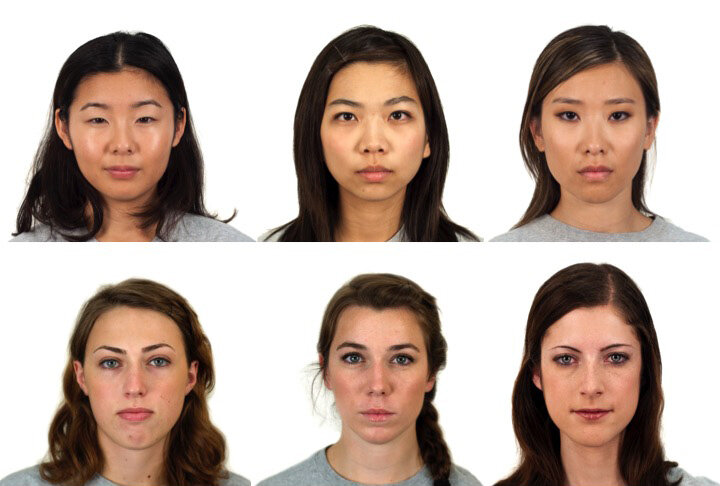Previous study results have suggested that people generally comprehend and evaluate the pronunciation of a speaker less well if they suspect that the speaker is ethnically foreign. However, a new study by Dr. Adriana Hanulíková, junior professor of language and cognition at the German Department of the University of Freiburg, shows that the relationships between language comprehension, pronunciation evaluation, and expected speaker origin are more complex than originally thought.
In her experiment, Hanulíková played German-language recordings with standard pronunciation, a Palatine accent and a Korean accent to test subjects and showed them alternating portrait photos of supposedly corresponding speakers: three women with Asian, three with European appearance. If the appearance matched the accent, the subjects were better able to repeat and transcribe the utterances. At the same time, they rated the pronunciation of all speakers as worse when shown photos of the women with Asian appearance, but with gradual differences in different age groups. It was the first study of its kind in the European language area and also the first in the world to differentiate between age groups and to work with subjects outside a university context. Adriana Hanulíková published her results in the journal Plos One. They will also be the basis for her work within the new research focus Diversity in Language and Cognition at the Freiburg Institute for Advances Studies (FRIAS).
The more expectations match the pronunciation, the better we understand
When the 172 subjects were played recordings in a Palatine accent and simultaneously saw an Asian-looking face as the speaker, they were less able to transcribe and repeat the statements after a short adaptation phase than when they heard the exact same recording and saw a European-looking face as the speaker. However, when they heard a recording with a Korean accent and saw an Asian-looking face in addition, they were able to understand the recording better than when it was associated with a European-looking face. “This result suggests that our language comprehension is influenced by origin-based expectations in a very specific way,” says Hanulíková. “Namely, the more closely our expectations match the pronunciation, the better we understand the person.”
“However, there are age-related individual differences here that previous studies have not yet captured,” says Hanulíková. The aforementioned effect is most pronounced in the youngest cohort (12–16 years old) and the oldest (70–92), and least pronounced in the middle cohort (30–45). The latter understands the standard language, the Palatine dialect and the Korean accent in the same way, whether from a supposedly native or foreign speaker. “Among other things, this allows us to assume,” says Hanulíková, “that we are dealing with very diverse groups in terms of experience and cognitive demands. This may lead to substantial differences in the way social information is taken into account in language comprehension.”
Age differences are also apparent in pronunciation evaluation
In her study, the German scholar also arrived at a more differentiated picture with regard to pronunciation evaluation. Regardless of whether the test subjects listened to a recording with standard German, a Palatine dialect or a Korean accent: In all cases, pronunciation was rated as worse when the subjects saw an Asian-looking face. This confirms previous prejudice-centered studies on language comprehension. However, these studies have not yet investigated whether and how pronunciation ratings vary depending on age. “My results, meanwhile, show that older subjects generally rated Asian women’s pronunciation more negatively than European women’s, but there are exceptions among younger subjects,” says Hanulíková. Origin-based prejudices can therefore be reinforced by cognitive demands in old age, among other factors.
Hanulíková has also broken new ground in the selection of subjects with regard to their social background. Previous studies on the topic, which were mostly conducted in the U.S. or Canada, have mostly worked with subjects who come from a university environment. “But this can lead to a bias in the results,” explains Hanulíková, “because the students, who are often psychology students, form a relatively homogeneous group. Thus, generalizing from students to a general and heterogeneous population is problematic, especially when evaluating pronunciation, which is closely related to social attitudes.”
“With the study, I also wanted to contribute to a clarification of conflicting theories in the field,” Hanulíková explains in summary. “Prejudice-based theories assume that ethnic prejudice per se leads to poorer evaluation and comprehension of people categorized as non-native speakers. Other models assume that such negative effects emerge only when there is a discrepancy between heard pronunciation and assumed origin of the person speaking. My study suggests more nuanced effects, and that the conflicting results depend on the particular methods used.”
More information:
Adriana Hanulíková et al, Do faces speak volumes? Social expectations in speech comprehension and evaluation across three age groups, PLOS ONE (2021). DOI: 10.1371/journal.pone.0259230
Provided by
University of Freiburg
Citation:
Study offers new insights into how we comprehend and evaluate pronunciation (2021, November 17)



